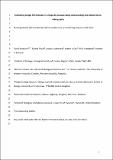Files in this item
Estimating pelagic fish biomass in a tropical seascape using echosounding and baited stereo-videography
Item metadata
| dc.contributor.author | Letessier, Tom B. | |
| dc.contributor.author | Proud, Roland | |
| dc.contributor.author | Meeuwig, Jessica J. | |
| dc.contributor.author | Cox, Martin J. | |
| dc.contributor.author | Hosegood, Phil J. | |
| dc.contributor.author | Brierley, Andrew S. | |
| dc.date.accessioned | 2022-11-29T00:42:39Z | |
| dc.date.available | 2022-11-29T00:42:39Z | |
| dc.date.issued | 2021-11-29 | |
| dc.identifier | 277015364 | |
| dc.identifier | 0c539c60-ce51-4934-9359-b60289a071fd | |
| dc.identifier | 85120066819 | |
| dc.identifier | 000723508800002 | |
| dc.identifier.citation | Letessier , T B , Proud , R , Meeuwig , J J , Cox , M J , Hosegood , P J & Brierley , A S 2021 , ' Estimating pelagic fish biomass in a tropical seascape using echosounding and baited stereo-videography ' , Ecosystems , vol. First Online . https://doi.org/10.1007/s10021-021-00723-8 | en |
| dc.identifier.issn | 1435-0629 | |
| dc.identifier.other | RIS: urn:0208904E7615492FCA356991B2A6789A | |
| dc.identifier.other | RIS: Letessier2021 | |
| dc.identifier.other | ORCID: /0000-0002-6438-6892/work/104618883 | |
| dc.identifier.other | ORCID: /0000-0002-8647-5562/work/104619080 | |
| dc.identifier.uri | https://hdl.handle.net/10023/26513 | |
| dc.description | This paper is an output of the Bertarelli Programme in Marine Science, and we are grateful for the Bertarelli Foundation’s support. | en |
| dc.description.abstract | The pelagic ecosystem is the ocean’s largest by volume and of major importance for food provision and carbon cycling. The high fish species diversity common in the tropics presents a major challenge for biomass estimation using fisheries acoustics, the traditional approach for evaluating mid-water biomass. Converting echo intensities to biomass density requires information on species identity and size, which are typically obtained by lethal means, and thus unsuitable in the portion of the ocean that is ‘no take’. To improve conservation and ecosystem-based management, we present a procedure for determining fish biomass density, using data on species identity, relative abundance, and lengths obtained from stereo baited remote underwater video systems (stereo-BRUVS) to inform the scaling of echosounder survey data (at 38 kHz). We apply the procedure in the British Indian Ocean Territory marine protected area, using acoustic data from 3025 km of survey transects and 546 BRUVS deployments recording relative abundance and size of 12,335 individual fish. Using a Generalised Additive Model of biomass density (GAM, adjR2 = 0.61) we predict, on the basis of oceanographic conditions and bathymetry, that the top 200 m pelagic ecosystem in the Chagos Archipelago, some 118,324 km2, held 3.84 (2.66, 5.62, 95% CI), 33.09 (23.41, 47.35) and 4.08 (3.1, 5.44) million tonnes of fish in November 2012, January 2015, and February 2016, respectively. Our non-extractive procedure yields ecologically credible patterns in biomass across multiple temporal (hours and years) and spatial (metres and kilometres) scales, and marks an improvement on the use of echo intensity alone as a biomass proxy. High seasonal and interannual variability has implication for pelagic fish monitoring. | |
| dc.format.extent | 18 | |
| dc.format.extent | 450985 | |
| dc.language.iso | eng | |
| dc.relation.ispartof | Ecosystems | en |
| dc.subject | Mid-water BRUVS | en |
| dc.subject | Marine protected areas | en |
| dc.subject | No-take | en |
| dc.subject | Non-extractive | en |
| dc.subject | GC Oceanography | en |
| dc.subject | QH301 Biology | en |
| dc.subject | NDAS | en |
| dc.subject | SDG 14 - Life Below Water | en |
| dc.subject | AC | en |
| dc.subject.lcc | GC | en |
| dc.subject.lcc | QH301 | en |
| dc.title | Estimating pelagic fish biomass in a tropical seascape using echosounding and baited stereo-videography | en |
| dc.type | Journal article | en |
| dc.contributor.institution | University of St Andrews. School of Biology | en |
| dc.contributor.institution | University of St Andrews. Scottish Oceans Institute | en |
| dc.contributor.institution | University of St Andrews. Pelagic Ecology Research Group | en |
| dc.contributor.institution | University of St Andrews. Centre for Research into Ecological & Environmental Modelling | en |
| dc.contributor.institution | University of St Andrews. Marine Alliance for Science & Technology Scotland | en |
| dc.identifier.doi | https://doi.org/10.1007/s10021-021-00723-8 | |
| dc.description.status | Peer reviewed | en |
| dc.date.embargoedUntil | 2022-11-29 |
This item appears in the following Collection(s)
Items in the St Andrews Research Repository are protected by copyright, with all rights reserved, unless otherwise indicated.

